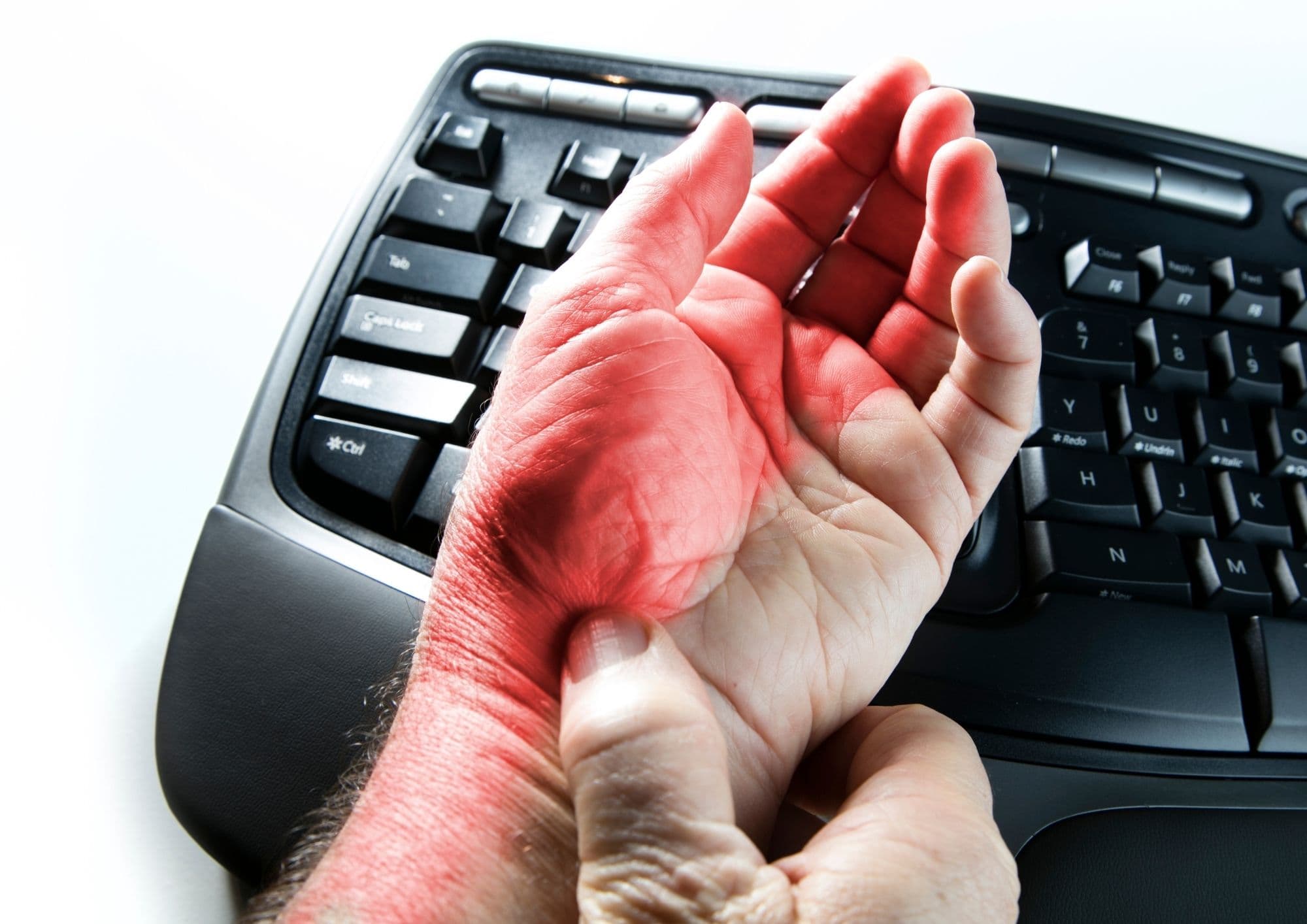Carpal tunnel syndrome (CTS), also referred to as median nerve compression, is a condition that affects many people in various industries.
Aside from disrupting work productivity, it can also prevent some from working altogether. The question now is how can people avoid this condition and prevent it from worsening at the workplace?
Can a standing desk help carpal tunnel syndrome then?
The Truth About Standing Desks and Carpal Tunnel Syndrome
Can a standing desk help you avoid CTS? Yes, it can. Standing desks are an excellent investment for reducing the risks of particular musculoskeletal disorders (MSDs) and cardiovascular diseases.
However, a standing desk can only do so much. You still have to modify your working style to avoid CTS or prevent it from worsening.
For instance, you can turn your workspace into an ergonomic one that’s kinder to your hands and wrists.
Standing desks generally ease the side effects of prolonged sitting, and this alone cannot help people with their CTS condition.
But there are ways to reduce the risks of CTS while using the standing desk. Keep reading to know more.
What Is Carpal Tunnel Syndrome?
To fully understand what CTS is all about, from occurrence to prevention, I have gathered all the facts you need to know. That way, you can quickly identify the condition and stop it from worsening.
What Is the Carpal Tunnel?
The carpal tunnel is a pathway where the body’s nine flexor tendons work to make the wrist and fingers move and function. This part also involves the arteries, median nerve, lymphatic vessels and blood.
The backside of the wrist is where the carpal bones line up, while the transverse carpal ligament is at its front side.
What Causes Carpal Tunnel Syndrome to Develop?
The muscles of our fingers and wrists are frequently utilised in movements with one-way patterns like typing, gripping or squeezing.
A muscle imbalance then happens and causes the carpal bones to budge.
The carpal tunnel, which is just as small as the index finger, becomes even smaller and, in turn, interrupts the structure inside it. This reaction then leads to numbing, tingling and pain around the area.
Carpal Tunnel Syndrome Symptoms
Here are some of the more common symptoms of CTS:
- Numbness
- Tingling sensation
- Paresthesia or pins and needles
- Pain and stiffness on the hand’s front side
- Loss of grip strength
- Loss of coordination
Factors that contribute to the development of the condition include habitual wrist flexing and over-typing. Treatment for CTS includes appropriate medical care and ergonomic changes in the office or workspace. It can also be treated with surgery if needed.

What Are the Common Jobs Associated with Carpal Tunnel Syndrome?
Many jobs involve physical labour. That means workers might be obligated to carry, grasp or move heavy items daily.
Some tasks, however, may not require the entire body, but they entail cyclic movements of specific body parts like typing. Using the same muscle groups and joints for years can result in conditions like CTS.
Here are some professions where employees are at risk of CTS.
1. Factory Workers
Assembling small items, gripping items on conveyor belts and using air-powered hand devices can cause CTS.
2. Farm Workers
Specific farm tasks might lead to CTS. The use of tools, milking of cows, deboning of fish and meats, and boxing of products might compromise the wrists.
3. Gardeners
Weeding by hand and using tools repeatedly for years can contribute to CTS.
4. Mechanics
The use of electrical or air-powered and manual tools might cause CTS in the long run. The same can also happen when using the wrong size of gloves.
5. Musicians
Pianists, guitarists and violinists use their hands to make music, making them susceptible to CTS.
6. Cashiers
Repeatedly using laser scanners during checkout, stamping and hitting the safety lever might lead to CTS.
7. Tailors and Seamstresses
Sewing, designing patterns, cutting, and creating embroidered and knitted products make the wrists vulnerable to CTS.
8. Locksmiths
Constantly turning keys and working with small objects may result in CTS.
9. Janitors And Cleaners
Scrubbing, mopping and handling heavy objects can trigger the development of CTS.
Does a Standing Desk Help with Carpal Tunnel Syndrome?
I have explained earlier how standing desks help carpal tunnel syndrome. While it cannot mitigate CTS on its own, you can apply preventative measures to reduce the risk of contracting it.
1. Maintain an Ergonomic Workstation
Create a comfortable and ergonomic workstation by making your frequently used desk items more accessible.
2. Check Your Computer Set-Up
Make sure that your computer set-up helps limit unnecessary hand and wrist movements.
The desk should also be at a height that will keep your hand in a neutral position. Your wrists should not bend during keyboard use, too.
3. Focus on Your Posture
Maintain a good posture at all times to avoid awkward standing positions. Keep your hands at a neutral angle and make all your work items easily accessible.
4. Take Regular Breaks
One of the primary causes of CTS is repetitive movement. Typing or jotting down notes make your hands and wrists vulnerable to CTS. Avoid the risks by taking breaks and switching hand positions.
What Are the Measures I Can Take to Prevent Carpal Tunnel Syndrome?
When it comes to CTS prevention, you have to mind the positioning of your wrists whenever you are seated or standing at work. Here are the tips to remember.
1. Maintain a Neutral Position of the Wrist
A neutral position means your hand must align with the wrist. Doing so lessens the pressure you put on it.
2. Keep the Wrists Straight
When seated or standing at work, see to it that your wrists are kept straight without bending or curving fingers outward or inward.
3. Maintain a Relaxed Grip
Always maintain a relaxed grip when grasping objects, whether a pen, a mouse or a coffee spoon at work.
4. Include Intervals
Stop and allow your hand to rest for a while after moving, twisting or bending the wrists at work. Do not allow continuous application of those motions for an extended period.

Try These Hand Exercises for Carpal Tunnel Syndrome
For those experiencing mild to moderate CTS symptoms, try performing these exercises along with the preventative measures listed earlier.
1. Wrist Flexor Stretch
- Pull out your arm in front with your palm up.
- Bend the wrist back. Aim the hand at the floor.
- Using the other hand, slightly bend the wrist until you sense a stretch within the forearm.
- Hold for 15-30 seconds.
- Repeat the same steps 2-4 times.
2. Tendon Gliding
- Begin by bending your elbow. Keep your wrist straight.
- Put your fingers together and aim them at the ceiling with your thumb relaxed.
- Curl fingers inwards. Straighten fingers to create an L shape, with your thumb relaxed.
- Fold fingers straight down. Curl the fingers into a fist.
- Repeat ten times, then perform the exercise 2-3 times daily.
3. Nerve Gliding
- Bend the elbow. With a neutral wrist, straighten the fingers out until they point upwards.
- Keep your thumb pushed in, aiming up. Bend the wrist to aim fingertips away from yourself. Make sure the thumb is still close to the fingers.
- Pull out the thumb to the side. Hold this position, then turn your forearm away from yourself.
- Use the other hand to pull the thumb down gently to stretch a bit.
- Do this for several seconds and repeat 3-5 times.
- Perform the exercise 2-3 times daily.
Conclusion
Standing desks help CTS only if combined with other preventative measures. Maintaining an ergonomic-friendly workspace is one of the best practices that you can apply to reduce the risks.
If you experience mild symptoms, you can perform a few of the exercises mentioned in this post.
Informative Q&A
1. Does using a standing desk help your sciatica?
Sitting puts plenty of pressure on the discs between the vertebrae, further inflaming and irritating the compressed nerves.
Standing desks help ease sciatica symptoms as a standing position lessens the pressure on those parts. Alternating between sitting and standing positions at work makes the condition more bearable, too.
2. Do you need a standing mat for a standing desk?
Standing mats make standing desk use more comfortable, especially for first-time users. Other advantages of these mats include compression reduction and better, improved blood flow around the legs.
- 6 Benefits of Using Seat Cushion - February 20, 2024
- 4 Tips to Fix Uncomfortable Chair - February 19, 2024
- How to Position Lumbar Support on Ergonomic Chair - February 15, 2024

